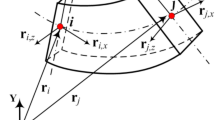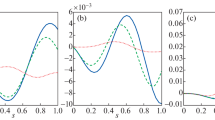Abstract
The authors developed the transfer mass coefficient method (TMCM) in order to compute effectively the dynamic response of a beam structure. In this paper, the algorithm for the dynamic response analysis of a three-dimensional beam structure is formulated. Through the computation results of numerical models, which are plane and space beam structures, obtained by the transfer mass coefficient method and the direct integration method, we verify that the transfer mass coefficient method can remarkably decrease the computation time of the direct integration method without the loss of accuracy in spite of using small computer storage.
Similar content being viewed by others
References
J. W. Tedesco, W. G. McDougal and C. A. Ross, Structural dynamics theory and applications, Addison Wesley Longman, California, USA, (1999).
K. J. Bathe, Finite element procedures, Prentice-Hall, New Jersey, USA, (1996).
M. Petyt, Introduction to finite element vibration analysis, Cambridge University Press, Cambridge, England, (1990).
H. Yamakawa and T. Ohnishi, Dynamic response analysis of structures with large degrees of freedom by step-by-step transfer matrix method, Bulletin of the JSME, 26(211) (1983) 109–116.
A. S. Kumar and T. S. Sankar, A new transfer matrix method for response analysis of large dynamic systems, Computers & Structures, 23(4) (1986) 545–552.
M. Ohga and T. Shigematsu, Transient analysis of plates by a combined finite element-transfer matrix method, Computers & Structures, 26(4) (1987) 543–549.
M. Ohga, T. Shigematsu and T. Hara, A finite element-transfer matrix method for dynamic analysis of frame structures, J. Sound and Vibration, 167(3) (1993) 401–411.
H. Xue, A combined finite element-riccati transfer matrix method in frequency domain for transient structural response, Computers & Structures, 62(2) (1997) 215–220.
A. S. Ashour and A. M. Farag, A combination between Laplace transform, strip method and transition matrix for determination of dynamic response and dam** effect of plates, International Journal of Acoustics and Vibration, 5(4) (2000) 191–195.
T. Inoue, A. Sueoka and T. Fusimoto, Time historical response analysis of large-scaled structures (improvement of computational efficiency and numerical stability by applying the transfer influence coefficient method), Trans. of JSME, Series C, 62(604) (1996) 4558–4566.
E. C. Pestel and F. A. Leckie, Matrix methods in elastomechanics, McGraw-Hill, New York, USA, (1963).
A. Sueoka, T. Koudou, D. H. Moon, K. Yamashita and H. Tamura, Free vibration analysis of a multiple straight line structure regarded as a discrete system by the transfer influence coefficient method, JSME International Journal, Series III, 32(1) (1989) 10–18.
T. Koudou, A. Sueoka, Y. Yasuda and D. H. Moon, Free vibration analysis of a tree structure by the transfer influence coefficient method (2nd report, treatment of a three-dimensional tree structure and numerical computational results), JSME International Journal, Series III, 35(1) (1992) 32–40.
L. L. Logan, A first course in the finite element method, PWS Publishing Company, Boston, USA, (1993).
Y. W. Kwon and H. Bang, The finite element method using Matlab, Second Ed., CRC Press, New York, USA, (2000) 237–306.
S. G. Kelly, Fundamentals of mechanical vibrations, Second Ed., McGraw-Hill, International Editions, (2000) 501–534.
Author information
Authors and Affiliations
Corresponding author
Additional information
This paper was recommended for publication in revised form by Associate Editor Hong Hee Yoo
Myung-Soo Choi received his B.S. and M.S. degrees from National Fisheries University of Pusan, Korea, in 1992 and 1994, respectively. He then received his Ph.D. degree from Pukyong National University in 1999. Dr. Choi is currently an Assistant Professor at the Department of Maritime Police Science at Chonnam National University in Yeosu, Korea. His research interests include mechanical vibration, structural dynamics, and optimum design.
Jung-Joo Suh received his B.S., M.S. and Ph.D. degrees from National Fisheries Uni-versity of Pusan, Korea, in 1972, 1985 and 1995, respec-tively. Dr. Suh is currently a Professor at the Faculty of Marine Technology at Chonnam National University in Yeosu, Korea. His research interests include internal combustion engines and numerical analysis.
Dong-Jun Yeo received his B.S., M.S. and Ph.D. degrees from National Fisheries University of Pusan, Korea, in 1981, 1985 and 1996, respectively. Dr. Yeo is currently a Professor at the Faculty of Marine Technology at Chonnam National University in Yeosu, Korea. He serves as an Academic Director of the Korean Society for Power System Engineering. His research interests include structural dynamics, vibration, and analytic techniques.
Jung-Kyu Yang received his B.S. degree from Pusan Fisherise College, Korea, in 1973. He then received his M.S. and Ph.D. degrees from Chungnam National University in 1985 and 1996, respectively. Dr. Yang is currently a Professor at the Faculty of Marine Technology at Chonnam University in Yeosu, Korea. His research interests include combustion engineering, air flow characteristics, and numerical analysis.
Jung-Hwan Byun received his B.S. and M.S. degrees from National Fisheries University of Pusan, Korea, in 1992 and 1995, respectively. He then received his Ph.D. degree from Pukyong National University in 1997. Dr. Byun is currently an Associate Professor at the Faculty of Marine Technology at Chonnam National University in Yeosu, Korea. His research interests include numerical analysis and synchronous control.
Rights and permissions
About this article
Cite this article
Choi, M.S., Yeo, D.J., Byun, J.H. et al. Development of dynamic response analysis algorithm for beam structures using transfer of mass coefficient. J Mech Sci Technol 23, 389–400 (2009). https://doi.org/10.1007/s12206-008-1226-7
Received:
Revised:
Accepted:
Published:
Issue Date:
DOI: https://doi.org/10.1007/s12206-008-1226-7




